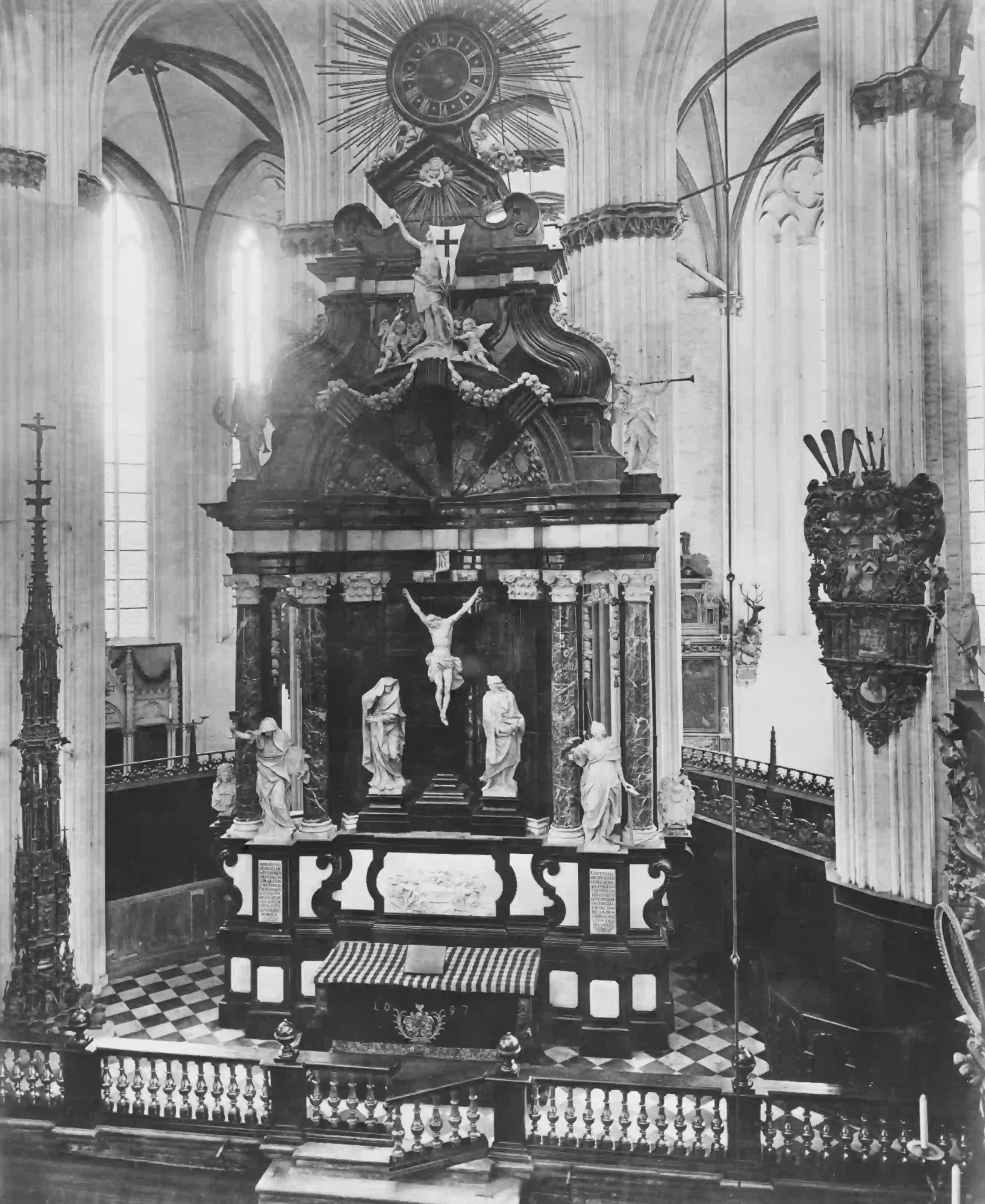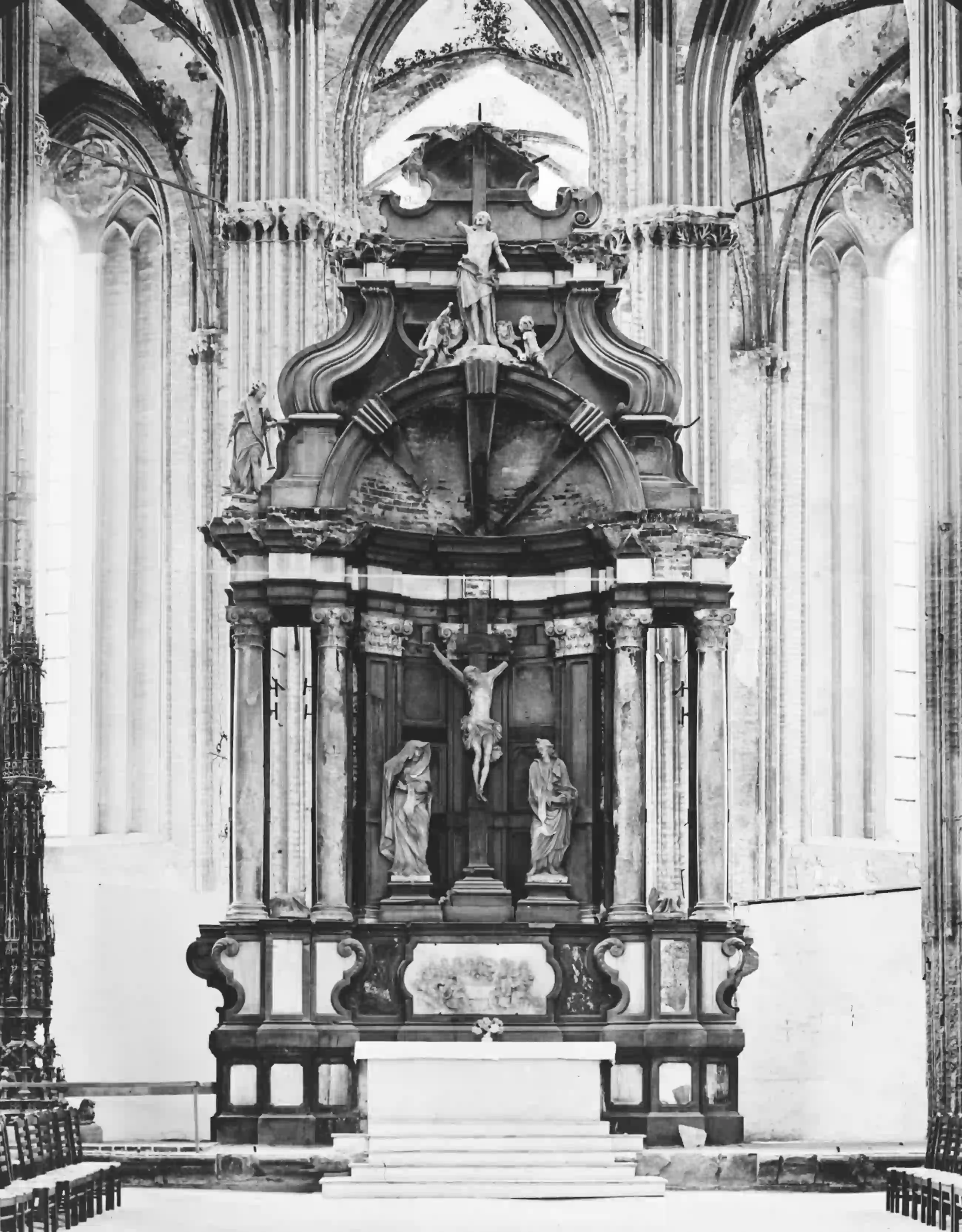Fredenhagen Altar
Masterpiece of North German Baroque art
An important altar for an important city: donated in 1697 by merchant Thomas Fredenhagen, created by Thomas Quellinus. The masterpiece of North German Baroque and more relevant than ever.
In This Section
The Fredenhagen Altar
(by Svea Regine-Feldhoff)
St Marien in its present form was built in the decades before and after 1300. It was an expression of the proud and wealthy bourgeoisie of an imperial city. The church was built right next to the town hall and the market square on the highest point of the city. It was the church of the council and the merchants, so there was always a close connection to the merchant class. Since the 17th century, for example, the Lübeck evening concerts at St Marien were sponsored by the merchant class. Under canon law, St Marien, like all other churches in Lübeck, was subject to the cathedral chapter. Therefore, the thesis that the merchants wanted to provocatively oppose spiritual power with secular power is questionable, to say the least.
Wealthy citizens were eager to leave a mark in "their" church. High-quality sacred artworks were donated. The tombs or cenotaphs, i.e. symbolic graves dedicated solely to the memory of a person, which were originally embedded in the floor, increasingly moved to the pillars and walls. Initially, these were commemorative plaques with inscriptions, but in the 16th and 17th centuries in particular, elaborate epitaphs were created to reflect the growing need for representation and the enormous influence of merchants not only in the economic sphere, but also in the political and cultural spheres.
One of the most prolific epitaph artists of his time was the Antwerp sculptor Thomas Quellinus (1661–1709), who ran a large workshop in Copenhagen that was well known throughout Europe. His most famous work in northern Germany is the altar he created for St Marien on behalf of Lübeck councillor Thomas Fredenhagen (1627-1709). Quellinus worked on this altar partly in the church itself, as it had to fit exactly between the two columns in the high choir.

"The enormous marble structure, perfectly tailored to the dimensions of the choir, was a major work of Flemish late Baroque art of European significance and had a considerable influence on altar art in the country" (Lutz Wilde in Dehio, Handbuch der Deutschen Kunstdenkmäler. Hamburg, Schleswig-Holstein 1971, p. 337).
In fact, the altars in St Aegidien or St Jakobi in Lübeck, for example, can also be considered epigonal, while the Fredenhagen altar in St Marien provides evidence of an innovative original from an art-historical perspective.
Thomas Fredenhagen had amassed enormous wealth as a merchant and shipowner, and was probably the richest man in Lübeck at the time. He had been a member of the church council of St Marien since 1680. In 1695, Fredenhagen granted the city of Lübeck a loan of 100,000 Lübeck marks, an unimaginably large sum. In August 1697, the new altar was completed. Of course, Fredenhagen also had an ulterior motive – the altar was also to be his own tomb. For this purpose, a crypt was built into the base.
The foundation of the altar was the largest at a church in Lübeck since the Reformation. The Fredenhagen Altar can also be regarded as the most significant post-Reformation sacred work of art in Northern Europe to date.

Until the bombing of Palmarum in 1942, the interior of St Marien was dominated by Baroque epitaphs: over 80 had been preserved until then, and another 60 or so are known to have existed from documents. The bombing destroyed all the wooden epitaphs in the nave, and the altar was also severely damaged. The congregation decided not to restore it, but instead left it standing, similar to the destroyed bells, as a reminder of the war. The Fredenhagen altar was not demolished until 1958 at the special request of the bishop at the time. Marien Church organist Walter Kraft also spoke out in favour of demolition, so the church council made this decision. It was controversial from the outset, and numerous publications continue to document this discourse to this day. Those in favour of demolition welcomed a further liberation from Baroque art, praised the resulting free space and pursued a re-Gothicisation of the church interior. Those in favour of restoring the Fredenhagen altar were and are aware of the altar's significance as a work of art, its importance for the city, the music and the acoustics of the church interior.
The base of the Fredenhagen altar remained in place and disappeared into the embankment that was built to raise the choir significantly. A simple limestone altar table was placed on top of it. A crucifix by the artist Gerhard Marcks was hung above it. A small Gothic altar dedicated to the Virgin Mary from a side chapel completed the new ensemble. These measures remain controversial to this day.
At present, the Fredenhagen altar has been dismantled: some of the marble figures are located in various places around the church, while the basic structure is stored in the north tower.
Addendum 2025: Initial considerations are underway to rebuild the altar as part of the major upcoming renovation and redesign of the church.
The altar and the music in the church interior
By Marienorganist Johannes Unger
While the Gothic hall church, built in the 13th century, was initially a place for unison singing, for example during the Liturgy of the Hours, over the centuries the complexity of the music developed in parallel with the acoustic conditions, which were mainly determined by the increasing interior furnishings of the church (pews, epitaphs, galleries, organs, choir stalls, high altar, flags). For polyphony and the multi-choir arrangement documented for St Marien (up to six ensembles simultaneously), evenly distributed sound and reduced reverberation times were essential in the 16th and 17th centuries and were most likely achieved, even though the size of the space always posed a challenge for the musicians.
The destruction wrought by the war in 1942 changed the acoustic conditions back to those of the 13th century in one fell swoop. All of the wooden and marble fixtures, the choir loft (rood screen) that structured the space, the many surfaces that reflected sound diffusely, even the sound-absorbing lime paints had disappeared. The demolition of the large Fredenhagen altar, the last remaining large reflective surface in the high choir, marked the end of a sudden development that made it extremely difficult to make music in this space in many respects.


